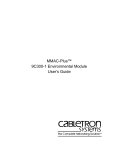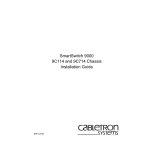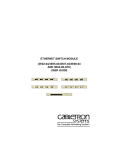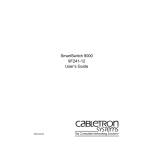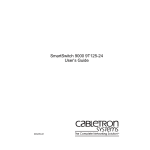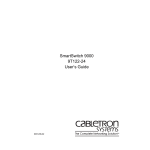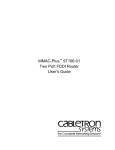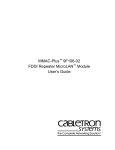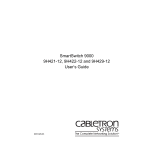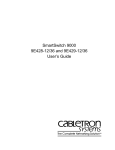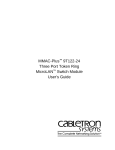Download Cabletron Systems 9C714 Installation guide
Transcript
MMAC-Plus™ Installation Guide for Use with the 9C114 and 9C714 Chassis Notice Notice Cabletron Systems reserves the right to make changes in specifications and other information contained in this document without prior notice. The reader should in all cases consult Cabletron Systems to determine whether any such changes have been made. The hardware, firmware, or software described in this manual is subject to change without notice. IN NO EVENT SHALL CABLETRON SYSTEMS BE LIABLE FOR ANY INCIDENTAL, INDIRECT, SPECIAL, OR CONSEQUENTIAL DAMAGES WHATSOEVER (INCLUDING BUT NOT LIMITED TO LOST PROFITS) ARISING OUT OF OR RELATED TO THIS MANUAL OR THE INFORMATION CONTAINED IN IT, EVEN IF CABLETRON SYSTEMS HAS BEEN ADVISED OF, KNOWN, OR SHOULD HAVE KNOWN, THE POSSIBILITY OF SUCH DAMAGES. © Copyright March 1997 by: Cabletron Systems, Inc. 35 Industrial Way Rochester, NH 03867-0505 All Rights Reserved Printed in the United States of America Order Number: 9031125-02 March 1997 LANVIEW and MMAC-Plus are registered trademarks of Cabletron Systems, Inc. i Notice FCC Notice This device complies with Part 15 of the FCC rules. Operation is subject to the following two conditions: (1) this device may not cause harmful interference, and (2) this device must accept any interference received, including interference that may cause undesired operation. NOTE: This equipment has been tested and found to comply with the limits for a Class A digital device, pursuant to Part 15 of the FCC rules. These limits are designed to provide reasonable protection against harmful interference when the equipment is operated in a commercial environment. This equipment uses, generates, and can radiate radio frequency energy and if not installed in accordance with the operator’s manual, may cause harmful interference to radio communications. Operation of this equipment in a residential area is likely to cause interference in which case the user will be required to correct the interference at his own expense. WARNING: Changes or modifications made to this device which are not expressly approved by the party responsible for compliance could void the user’s authority to operate the equipment. DOC Notice This digital apparatus does not exceed the Class A limits for radio noise emissions from digital apparatus set out in the Radio Interference Regulations of the Canadian Department of Communications. Le présent appareil numérique n’émet pas de bruits radioélectriques dépassant les limites applicables aux appareils numériques de la class A prescrites dans le Règlement sur le brouillage radioélectrique édicté par le ministère des Communications du Canada. VCCI Notice This equipment is in the 1st Class Category (information equipment to be used in commercial and/or industrial areas) and conforms to the standards set by the Voluntary Control Council for Interference by Information Technology Equipment (VCCI) aimed at preventing radio interference in commercial and/or industrial areas. Consequently, when used in a residential area or in an adjacent area thereto, radio interference may be caused to radios and TV receivers, etc. Read the instructions for correct handling. ii Notice DECLARATION OF CONFORMITY Application of Council Directive(s): Manufacturer’s Name: Manufacturer’s Address: European Representative Name: European Representative Address: Conformance to Directive(s)/Product Standards: Equipment Type/Environment: 89/336/EEC 73/23/EEC Cabletron Systems, Inc. 35 Industrial Way PO Box 5005 Rochester, NH 03867 Mr. J. Solari Cabletron Systems Limited Nexus House, Newbury Business Park London Road, Newbury Berkshire RG13 2PZ, England EC Directive 89/336/EEC EC Directive 73/23/EEC EN 55022 EN 50082-1 EN 60950 Networking Equipment, for use in a Commercial or Light Industrial Environment. We the undersigned, hereby declare, under our sole responsibility, that the equipment packaged with this notice conforms to the above directives. Manufacturer Legal Representative in Europe Mr. Ronald Fotino ___________________________________________________ Mr. J. Solari ________________________________________ Full Name Full Name Principal Compliance Engineer ___________________________________________________ Title Managing Director - E.M.E.A. ________________________________________ Rochester, NH, USA ___________________________________________________ Newbury, Berkshire, England ________________________________________ Location Location Title iii Notice iv MMAC-Plus Installation Guide Introduction This document contains information necessary to install the MMAC-Plus 9C114 and 9C714 chassis. It is designed for the initial installation only. For detailed operational information on the various MMAC-Plus components, refer to the following manuals: MMAC-Plus 9C300-1 Environmental Module User’s Guide MMAC-Plus 9C214-1 AC Power Supply Installation Guide MMAC-Plus 9C214-2 DC Power Supply Installation Guide Local Management User’s Guide In addition, each Interface Module has a User’s Guide. The MMAC-Plus The MMAC-Plus chassis is a networking platform that provides support for the configuration and operation of up to fourteen Cabletron Systems MMAC-Plus interface modules. Features Multiple Technology Support The design of the chassis allows it to provide support for existing and future Local Area Networking technologies such as Ethernet, Fast Ethernet, Gigabit Ethernet, Token Ring, Fiber Distributed Data Interface (FDDI), Systems Network Architecture (SNA), Wide Area Networks (WAN), and Asynchronous Transfer Mode (ATM). Redundant Power Supply Modules The 9C114 and 9C714 support the installation of two power supplies for power supply redundancy and load sharing. If a 9C500 Power Box is used, up to six power supplies may be installed. 9C300-1 Environmental Module The 9C300-1 Environmental Module provides out-of-band management capabilities, monitors power supply and environmental status, and has a built-in cooling system. The 9C300-1 Environmental Module is also “hot swappable” so that it can be removed for repair or replacement without causing network downtime. For details refer to the MMAC-Plus 9C300-1 Environmental Module User’s Guide. 1 MMAC-Plus Installation Guide The Backplane The 9C114 MMAC-Plus provides six distinct backplane buses, and the 9C714 provides an additional seventh bus, the Cell Transfer Matrix. Each bus serves a particular set of needs. The seven backplane buses are shown in Figure 1. System Management Bus 1 System Management Bus 10 Flexible Network Bus 1 Flexible Network Bus 2 Inter-Networking Bus A Inter-Networking Bus B Cell Transfer Matrix Figure 1. The MMAC-Plus Backplane Buses The descriptions of the seven backplane buses are as follows: System Management Bus 1 The System Management Bus 1, abbreviated SMB-1, is a management bus devoted solely to transferring management information between the modules in the chassis. It is through the SMB-1 that modules inform each other, and the Environmental Module, of their current operating status, diagnostic test results, initialization queries and other information. The SMB-1 operates at 1 Mbps, and every module in the chassis has a connection to it. 2 MMAC-Plus Installation Guide System Management Bus 10 The System Management Bus 10, or SMB-10, performs similar functions to those of the SMB-1 previously discussed in this section. The SMB-10 bus is devoted to the transfer of management data within the chassis, but is used for out-of-band or Local Management operations. The SMB-10 operates at Ethernet speeds of 10 Mbps, and is connected to any manageable module in the chassis. Access to the SMB-10 for Local Management operations is provided through an Ethernet Port Interface Module (EPIM) slot on the 9C300 Environmental Module, or through the serial COM ports, also located on the Environmental Module. The SMB-10 can also be accessed from in-band management through a Telnet application. The Flexible Network Buses The Flexible Network Buses, FNB-1 and FNB-2, are the primary backplane buses used to connect MMAC-Plus modules for shared network designs. Each FNB bus operates as a dual, counterrotating Fiber Distributed Data Interface (FDDI) ring. Each FNB bus operates at 100 Mbps, and consists of one primary ring and its associated secondary ring. In the event of a failure of a station or a connection, the signals from the primary ring are wrapped onto the secondary ring, creating a single ring and allowing network traffic to continue circulating. The construction of the FNB backplanes includes shunting connectors which allow network signals to pass by unpopulated slots in the chassis. This design frees Network Managers from a dependence on specific ordering or placement of modules, and allows modules to be removed from the FNB without causing a wrap of the FDDI ring. The Internal Network Buses The Internal Network Buses, abbreviated INB-1 and INB-2, are designed to simultaneously support both packet and ATM cell transport. Each INB data channel is 64 bits wide (56 byte data bus and 8 byte management and control bus) and runs at a clock rate of 40 mhz, yielding a sustained data rate of 2 Gbps, and a burst rate of 2.5 Gbps. The 8 byte management and control bus allows all signaling and bus arbitration functions to occur out-of-band with regard to user data. The Cell Transfer Matrix (installed in the 9C714 chassis only) The Cell Transfer Matrix provides a Time Division Multiplexed (TDM) based mesh of full duplex, high speed (1.6 Gbps) dedicated interconnections capable of carrying standard ATM cell traffic. These interconnections are a series of point-topoint links between an individual module, and every other module that directly connects to the Cell Transfer Matrix. If the 9C714 chassis has 14 modules that connect to the CTM installed, there are 182 point-to-point links between all the modules, providing a total aggregrate switching capacity of 75 Gbps. 3 MMAC-Plus Installation Guide Getting Help If you need additional support related to this device, or if you have any questions, comments, or suggestions concerning this manual, contact Cabletron Systems Technical Support: Phone (603) 332-9400 Monday – Friday; 8 A.M. – 8 P.M. Eastern Time CompuServe GO CTRON from any ! prompt Internet mail [email protected] FTP Login Password ctron.com (134.141.197.25) anonymous your email address Modem setting (603) 335-3358 8N1: 8 data bits, No parity,1 stop bit BBS For additional information about Cabletron Systems products, visit our World Wide Web site: http://www.cabletron.com/ Site Guidelines The following guidelines must be followed to select a suitable site for the MMAC-Plus. If not, unsatisfactory network performance may result. The site must have an unrestricted free surface area around the MMAC-Plus chassis, allowing for free movement of air. An open space of at least 84 high by 63.5 wide by 81.24 centimeters deep (33 high by 25 wide by 32 inches deep) is the minimum recommended. If the unit is installed in an enclosed equipment cabinet, the cabinet should have a built-in cooling fan.The maximum theoretical heat dissipation of the MMAC-Plus is 8700 BTUs per hour. Actual heat dissipation will vary depending on the modules installed in the MMAC-Plus chassis. The temperature of the location must be maintained between 5° and 40°C (40° and 104°F). Changes in temperature greater than 10°C (18°F) per hour should not occur. A standard 3-prong power receptacle must be located within 6 feet of the system. One circuit is recommended for each power supply. The AC wiring for the receptacle must be able to supply 12 amps at 120 volts or 6 amps at 220 volts. 4 MMAC-Plus Installation Guide Installation Required Tools The following tools are required to install the 9C114 and 9C714 chassis: • Phillips Screwdriver • Flathead Screwdriver • Electrostatic Discharge (ESD) Wrist Strap (provided with the chassis) Unpacking the MMAC-Plus Chassis Unpack the chassis by following the steps below: 1. Remove the unit from the shipping box. 2. Remove the protective plastic bag. 3. Remove the accessory package. 4. Remove the Electrostatic Discharge (ESD) Wrist Strap package. Installation Order Once a suitable site has been chosen, the MMAC-Plus may be installed. The unit may be free standing or rack mounted. It is recommended that the MMAC-Plus installation proceed in this order: 1. Mount the chassis to the rack or other secure location. 2. Install the power supply(ies). 3. Attach the Electrostatic Discharge (ESD) Wrist Strap. 4. Install the Environmental Module. 5. Install the Interface Modules. 6. If necessary, install the INB Terminator Modules. 5 MMAC-Plus Installation Guide Rack Mounting the Chassis The chassis can be mounted in a standard 19-inch equipment rack. If the rack is not secured to the floor, it is recommended that the MMAC-Plus be installed in the bottom half of the rack. This will prevent the rack from being top heavy. Two people may be required to lift the chassis into place. The chassis is secured with twelve bolts, six on each side. Using the bolts provided with the rack, bolt the chassis to the rack, starting with the bottom holes and working up, as shown in Figure 2. 1125_05 Figure 2. Rack Mounting the Chassis 6 MMAC-Plus Installation Guide Installing a Power Supply At least one power supply must be installed on the rear of the MMAC-Plus chassis. Additional power supplies can be added to achieve redundancy. A power supply is installed by plugging it into either the left or right power supply connector on the MMAC-Plus chassis, as shown in Figure 3. Install a power supply by following the steps below: 1. Unpack the power supply by removing it from the shipping box and sliding the two foam end caps off the unit. (Save the shipping box and packing materials in the event the power supply must be reshipped.) 2. Remove the power supply from the protective plastic bag. (Save the bag in the event the power supply must be reshipped.) 3. Examine the power supply carefully, checking for damage. If any damage exists, DO NOT install the power supply. Immediately contact Cabletron Systems Technical support. 4. Loosen and remove the two screws from one of the power supply connector covers on the rear of the MMAC-Plus chassis. 5. Remove the cover. (Keep the cover in the event you need to remove the power supply. The cover must be replaced to protect the connector.) 6. Hold the power supply by the handles on the top and bottom of the unit and do the following: a. Align the power supply so that the lip on the bottom and the hook on the top are slightly above the corresponding slots on the chassis. b. Ease the power supply down until the hook catches the slot on the top and the tab is inserted in the slot on the bottom. c. Plug the power supply into the corresponding connector on the back of the chassis by pushing the power supply until its frame touches the surface of the MMAC-Plus chassis. Do not force the power supply in place. If significant resistance is encountered before the frame is flush with the chassis, remove the power supply, realign it, and push it in again. d. Secure the power supply to the chassis by tightening the four screws on the top and bottom of the power supply. For proper chassis grounding, the four slotted screws must be properly tightened. 7. If you are installing a second power supply, repeat steps 1–6. 7 MMAC-Plus Installation Guide 2 1 Slot on Chassis . . . . . . . . . . . . . . . . . . . . . . Securing Screws Tab 100-125v-12A 200-250v-6A 50-60 Hz Securing Screws Figure 3. Installing a Power Supply 8 MMAC-Plus Installation Guide Attaching the Electrostatic Discharge (ESD) Wrist Strap The ESD Wrist Strap must be attached before handling the Environmental Module or MMAC-Plus Interface Modules. In addition, observe all precautions when handling these modules to prevent damage from ESD. Attach the ESD Wrist Strap by following the steps below: 1. Attach one end of the ESD Wrist Strap to your wrist. 2. Plug the other end into the ESD Wrist Strap grounding receptacle in the front lower right corner of the MMAC-Plus chassis, as shown in Figure 4. ESD Grounding Receptacle 1125_01 Figure 4. Attaching the ESD Wrist Strap 9 MMAC-Plus Installation Guide Installing the Environmental Module The Environmental Module is installed in the slot above the module card cage in the front of the MMAC-Plus chassis, as shown in Figure 5, by following the steps below: 1. Unpack the Environmental Module by carefully removing it from the shipping box and sliding the two foam end caps off of the unit. (Save the shipping box and packing materials in the event the Environmental Module must be reshipped.) 2. Remove the Environmental Module from the protective plastic bag. (Save the bag in the event the Environmental Module must be reshipped.) Observe all precautions to prevent damage from Electrostatic Discharge (ESD). 3. Remove the plastic protective cap that covers the connector on the rear of the Environmental Module. 4. Examine the Environmental Module, carefully checking for damage. If any damage exists, DO NOT install the Environmental Module. Immediately contact Cabletron Systems Technical Support. 5. Hold the left and right sides of the Environmental Module. 6. Line up the rails on the left and right sides of the Environmental Module with the tracks on the left and right inside panels of the chassis. 7. Slide the Environmental Module into the chassis until it is completely seated. MMAC EPIM STATUS ALARM 9C3001 COM 1 COM 2 ENTER 1 2 3 4 5 6 7 8 9 10 11 12 13 14 1125_03 Figure 5. Installing the Environmental Module 10 MMAC-Plus Installation Guide Installing MMAC-Plus Interface Modules MMAC-Plus Interface Modules can be installed in any of the 14 slots that are available. To install Interface Modules, follow the steps below: 1. Remove the blank panel, covering the slot in which the Interface Module will be installed. All other slots must remain covered to ensure proper airflow and cooling. 2. Unpack the Interface Module by carefully removing it from the shipping box. (Save the box and packing materials in the event the module must be reshipped.) 3. Remove the Interface Module from the plastic bag. (Save the bag in the event the Interface Module must be reshipped.) Observe all precautions to prevent damage from Electrostatic Discharge (ESD). 4. Examine the Interface Module, carefully checking for damage. If any damage exists, DO NOT install the Interface Module. Immediately contact Cabletron Systems Technical Support. 5. Install the Interface Module in the chassis by sliding it in any available slot and locking down the top and bottom plastic tabs, as shown in Figure 6. Take care that the Interface Module slides in straight and properly engages the backplane connectors. When installing the Interface Module, ensure that the circuit card is between the card guides, as shown in Figure 6. Check both the upper and lower tracks. 6. If you are installing additional Interface Modules, repeat steps 1–5. 11 MMAC-Plus Installation Guide AN AN AN AN Plastic Locking Tab Plastic Locking Tab Metal Back-Panel Circuit Card Card Guides 2031_02 Figure 6. Installing MMAC-Plus Interface Modules 12 MMAC-Plus Installation Guide Attaching 9C614 INB Terminator Modules Two 9C614 INB Terminator Modules must be attached to the rear of the MMAC-Plus chassis when Interface Modules that use the INB are inserted in the front of the chassis. These modules provide proper termination for the Internal Network Bus (INB). The INB Terminator Modules are attached by following the steps below: NOTE 1. Remove the INB Terminator Modules from the shipping box. (Save the box and packing materials in the event the module must be reshipped.) 2. Hold the INB Terminator Module by the handle and line up the screws that extend from the module with the screw holes in one of the INB Termination Connectors on the rear of the MMAC-Plus chassis (Figure 7). 3. Push the INB Terminator Module in gently until the frame of the module touches the frame of the chassis. 4. Tighten the screws on the INB Terminator Module. 5. Repeat steps 1–4 to attach the second INB Terminator Module. The INB Terminator Module is designed to fit in either INB Termination Connector on the MMAC-Plus chassis. If the screws that extend from the module do not line up with the screw holes on the INB Connector, turn the module over. 2 1 . . . . . . . . . . . . . . . . . . . . . . 100-125v-12A 200-250v-6A INB Termination Connectors 50-60 Hz 1125_04 Figure 7. Attaching the INB Terminator Modules 13 MMAC-Plus Installation Guide Powering up the MMAC-Plus The MMAC-Plus chassis is powered up by following the steps below: 1. Plug one end of the power cord (supplied with the power supply) into the AC power socket on the lower right front corner of the power supply. 2. Plug the other end of the power cord into an AC receptacle. Turn on the power supply using the switch located near the power socket. 3. The power supply uses a soft start feature and does a pre-power diagnostic check. Outputs become enabled within 5 seconds of turning the power on. 4. Check that the PWR and SMB LEDs on the power supply are green. If the LEDs are any color other than green, refer to the Power Supply User’s Guide. 5. Check that all LEDs on the INB Terminator Module are green. If the LEDs are any color other than green, refer to the INB Terminator Module Installation Guide. 6. Check that the Status and Alarm LEDs on the Environmental Module are green. If the LEDs are not green, refer to the Environmental Module User’s Guide. 7. Check that the System Management Bus (SMB) and the Board OK (BOK) LEDs on the front panel of each installed Interface Module are green. (Be sure the boards have completed booting; this may take up to 20 seconds.) If an Interface Module’s SMB and BOK LEDs are not green, refer to the User’s Guide for that Interface Module. 14 MMAC-Plus Installation Guide Operating Specifications Environmental Requirements Operating Temperature: 5°C to 40°C (41°F to 104°F) Storage Temperature: -30°C to 90°C (-22°F to 194°F) Operating Relative Humidity: 5% to 90% (non-condensing) Regulatory Compliance Safety This equipment meets the safety requirements of UL 1950, CSA C22.2 No. 950, EN 60950, IEC 950 and 73/23/EEC. Electromagnetic Compatibility This equipment meets the requirements of FCC Part 15, EN 55022, VCCI V-3/93.01, CSA C108.8, EN 50082-1 and 89/336/EEC. 9C114 MMAC-Plus Chassis Dimensions 76.2 H x 48.3 W x 49.3 D centimeters (30 H x 19 W x 19.4 D inches) Weight Unit: 19.96 kilograms (44 pounds) Shipping:24.95 kilograms (55 pounds) 9C714 MMAC-Plus Chassis Dimensions 76.2 H x 48.3 W x 49.3 D centimeters (30 H x 19 W x 19.4 D inches) Weight Unit: 19.96 kilograms (44 pounds) Shipping:24.95 kilograms (55 pounds) 15 MMAC-Plus Installation Guide 9C300-1 Environmental Module Dimensions 12.7 H x 43.2 W x 44.5 D centimeters (5 H x 17 W x 17.5 D inches) Weight Unit: Shipping: 6.5 kilograms (14 pounds) 7.7 kilograms (17 pounds) 9C214-1 Power Supply Dimensions 61 H x 19.1 W x 14 D centimeters (24 H x 7.5 W x 5.5 D inches) Weight Unit: Shipping: 7.7 kilograms (17 pounds) 9.07 kilograms (20 pounds) 9C614 INB Terminator Module Dimensions 21.59 H x 2.22 W x 14.92 D centimeters (8.5 H x 0.875 W x 5.875 D inches) Weight Unit: Shipping: 16 0.45 kilograms (1 pound) 0.68 kilograms (1.5 pounds)






















